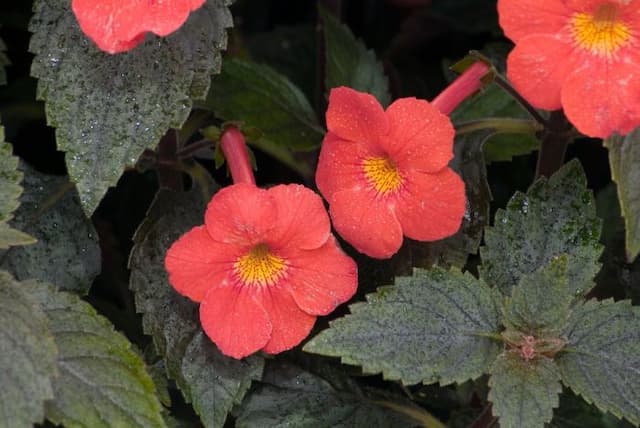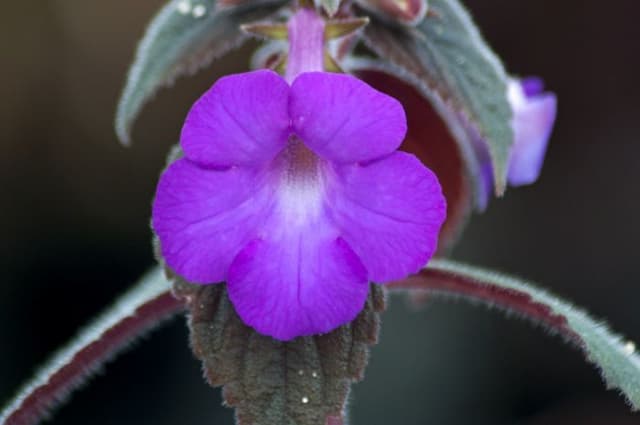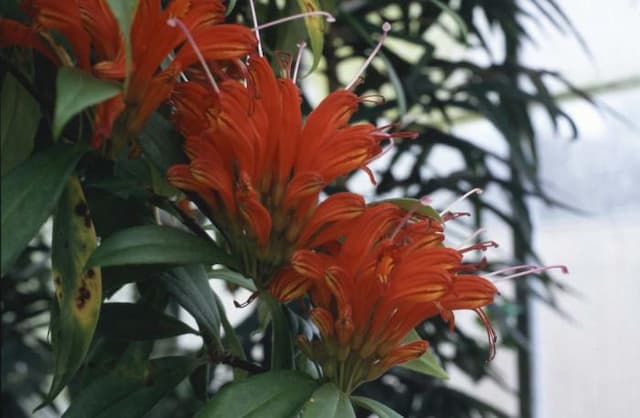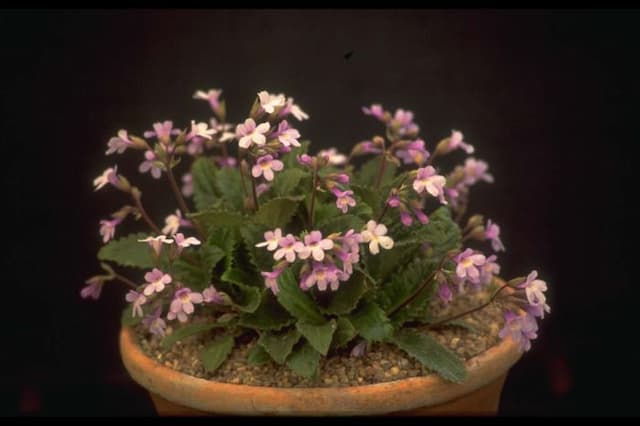Goldfish Plant Nematanthus 'Tropicana'

ABOUT
The Nematanthus 'Tropicana', commonly known as the Goldfish Plant, is a charming houseplant with a distinctive and attractive appearance. It features glossy, green leaves that are oval-shaped and somewhat thick, giving a succulent-like appearance to the foliage. The leaves generally grow in opposing pairs along the stems. The most striking feature of the Goldfish Plant is its unique flowers. They are small and shaped like leaping goldfish, with a combination of warm colors such as oranges, reds, and yellows, often with a soft, shiny texture, making the plant look vibrant and lively. These blooms typically appear at the stem ends or along the stem, nestled against the leaves, adding a whimsical and tropical feel to the plant. Its overall growth habit tends to be compact and sometimes trailing, making it an excellent choice for hanging baskets or elevated displays, allowing the stems to cascade gracefully. The appealing contrast between the green foliage and the colorful blooms makes the Goldfish Plant a visually delightful addition to indoor plant collections.
About this plant
 Names
NamesSynonyms
Goldfish Plant, Guppy Plant
Common names
Nematanthus 'Tropicana'.
 Toxicity
ToxicityTo humans
The plant commonly known as Guppy plant is generally not considered toxic to humans. However, as with many houseplants, it is not intended for consumption and ingesting parts of the plant may cause mild stomach upset or discomfort in some individuals. There is no widespread documentation of serious toxicity or poisoning from consuming the Guppy plant. It's always advisable to keep houseplants out of reach of young children who might ingest plant parts out of curiosity.
To pets
The Guppy plant is not commonly listed as toxic to pets such as dogs and cats. Though not intended for animal consumption, if a pet ingests a small amount of the plant, it is unlikely to cause serious harm. Nonetheless, pets may experience mild gastrointestinal upset if they consume parts of the Guppy plant. Signs might include vomiting or diarrhea. It's best to prevent pets from ingesting plants, as individual animals might have different sensitivities or allergic reactions.
 Characteristics
CharacteristicsLife cycle
Perennials
Foliage type
Evergreen
Color of leaves
Green
Flower color
Orange
Height
1-2 feet (30-60 cm)
Spread
1-2 feet (30-60 cm)
Plant type
Shrub
Hardiness zones
11
Native area
Brazil
Benefits
 General Benefits
General Benefits- Easy to Care - The plant is known for being low-maintenance, requiring minimal attention to thrive.
- Aesthetic Appeal - With its colorful blooms and unique foliage, it adds visual interest to any indoor space.
- Long Blooming Period - It can bloom for several months, providing long-lasting color and vibrancy.
- Drought Tolerant - Once established, it can tolerate periods of dryness, which is beneficial for forgetful waterers.
- Pet Friendly - It is non-toxic to cats and dogs, making it safe to keep around pets.
- Adaptable - It can be grown in a variety of indoor lighting conditions, from bright, indirect light to lower light areas.
- Compact Size - Its small size makes it ideal for windowsills, desks, and small living spaces.
- Trailing Habit - Its cascading stems make it a great choice for hanging baskets or as a trailing plant on shelves.
- Propagation Ease - Can be easily propagated through stem cuttings, making it simple to create new plants.
 Medical Properties
Medical PropertiesThis plant is not used for medical purposes.
 Air-purifying Qualities
Air-purifying QualitiesThis plant is not specifically known for air purifying qualities.
 Other Uses
Other Uses- Artistic inspiration: Due to its unique appearance and vibrant color, Nematanthus 'Tropicana' can be used by artists and designers as a source of inspiration for patterns, shapes, and color palettes in their work.
- Educational tool: Botany educators can use Nematanthus 'Tropicana' to teach students about epiphytic plants and their growing behaviors in tropical environments.
- Photography subject: With its striking flowers, Nematanthus 'Tropicana' can be a captivating subject for macro photography, helping photographers to showcase the details and textures of the plant.
- Theme gardens: This plant can be included in theme gardens, such as a 'tropical paradise' or 'fire-themed' garden, due to its fiery orange flowers that add a splash of color.
- Feng Shui: Some practitioners may use Nematanthus 'Tropicana' in Feng Shui arrangements, believing its vibrant growth promotes positive energy in a space.
- Color therapy: Because of its bright coloration, the plant could be positioned in spaces where color therapy principles are applied for mood enhancement or to stimulate creativity and vitality.
- Seasonal decorations: Its bright orange blooms make Nematanthus 'Tropicana' a potential candidate for a fall-themed decor, particularly around autumn celebrations like Halloween or Thanksgiving.
- Substitute for mistletoe: During the holiday season, some might use Nematanthus 'Tropicana' as a kissing plant, as an alternative to the traditional mistletoe, for its attractive hanging growth habit.
- Floristry: The long-lasting flowers and unusual growth pattern make Nematanthus 'Tropicana' a novel addition to floral arrangements, particularly in hanging baskets or as a trailing feature.
- Craft projects: Dried or pressed flowers of Nematanthus 'Tropicana' can be used in crafting, such as in making bookmarks, greeting cards, or other decorative items.
Interesting Facts
 Feng Shui
Feng ShuiThe Goldfish plant is not used in Feng Shui practice.
 Zodiac Sign Compitability
Zodiac Sign CompitabilityThe Goldfish plant is not used in astrology practice.
 Plant Symbolism
Plant Symbolism- Endurance: Named for its ability to thrive in tropical environments, Nematanthus 'Tropicana', also known as the Goldfish Plant, symbolizes endurance due to its nature of withstanding various living conditions.
- Eternal Friendship: With its long-lasting blooms and ongoing growth, the Goldfish Plant is often given as a gift to symbolize long-term friendship and relationships that stand the test of time.
- Optimism: The bright, cheerful flowers of the Goldfish Plant represent positivity and optimism, making it a perfect gift to uplift someone's spirits.
- Abundance: The Goldfish Plant's prolific flowering can signify abundance and wealth, both in the personal and material sense.
- Playfulness: The unique shape of its flowers, reminiscent of swimming goldfish, imparts a sense of whimsy and playfulness.
 Water
WaterThe Goldfish Plant prefers consistently moist but not soggy soil. Use lukewarm water to water the plant thoroughly whenever the top inch of soil feels dry to the touch, which may be about once a week, although this can vary depending on environmental conditions. Be cautious to avoid waterlogging, which can lead to root rot. Typically, you might use about 8-16 ounces of water for a small to medium pot, adjusting as necessary for larger pots or changing conditions. During winter, reduce watering frequency as the plant goes through a dormant phase.
 Light
LightGoldfish Plants thrive in bright, indirect light, making an east- or north-facing window an ideal spot. They can tolerate some morning sun but should be shielded from intense afternoon light to prevent leaf scorch. Keep the plant in a well-lit room, but avoid direct sunlight during the peak hours of the day to maintain vibrant leaf color and promote flowering.
 Temperature
TemperatureGoldfish Plants do best in a warm environment, with ideal temperature conditions ranging between 65°F and 75°F. They can survive in temperatures as low as 50°F but should be protected from cold drafts and sudden temperature fluctuations. Avoid placing your Goldfish Plant near heating vents or air conditioners, as these can create an unfavorable growing environment.
 Pruning
PruningPruning the Goldfish Plant encourages bushier growth and more blooms. Trim back leggy stems and any yellowing or dead foliage to maintain the plant's shape and health. The best time to prune is in the spring or after the plant has finished flowering, which is usually in the late winter or early spring. Pruning every few months or as needed will help to keep the plant looking its best.
 Cleaning
CleaningAs needed
 Soil
SoilThe best soil mix for the Goldfish Plant (Nematanthus 'Tropicana') should be well-draining and rich in organic matter. A mix of peat, perlite or pumice, and loamy soil works well. The soil pH should ideally be between 6.1 to 6.5.
 Repotting
RepottingGoldfish Plants should be repotted every 2 to 3 years when they have outgrown their current pot or when the soil becomes compacted. This encourages healthy growth and rejuvenates the potting mix.
 Humidity & Misting
Humidity & MistingGoldfish Plants thrive in high humidity conditions, ideally between 40% to 50%. Mist the plant regularly or place a humidifier nearby to maintain these levels.
 Suitable locations
Suitable locationsIndoor
Place Goldfish Plant in bright, indirect light and keep humid.
Outdoor
Grow in dappled shade; protect from direct sun and heavy frost.
Hardiness zone
10-12 USDA
 Life cycle
Life cycleThe life of a Nematanthus 'Tropicana', commonly known as "Guppy Plant," begins with germination, where the plant emerges from seed under warm and humid conditions. This is followed by the seedling stage, where primary leaves develop to start photosynthesis. As it grows, the Guppy Plant enters a vegetative phase, producing a bushy growth of shiny, waxy leaves out of which emerge long, slender stems. The plant then reaches maturity and starts the flowering stage, characterized by bright, pouch-like orange flowers resembling guppies, which is why it's named 'Tropicana'. After pollination, the plant produces small seed capsules, and once these seeds are dispersed, a new lifecycle can begin. Finally, as a perennial, the Guppy Plant can continue to grow and bloom annually with proper care, engaging in multiple flowering cycles.
 Propogation
PropogationPropogation time
Spring-Summer
Nematanthus 'Tropicana', commonly known as Guppy Plant, is best propagated during the spring and summer when the plant is actively growing. The most popular method is through stem cuttings. To propagate, select a healthy, non-flowering stem and cut a piece about 3 to 4 inches (approximately 7.5 to 10 centimeters) long. Remove the lower leaves and dip the cut end in rooting hormone powder to increase the chances of successful rooting. Plant the cutting in a pot filled with a well-draining potting mix, and keep the soil consistently moist but not waterlogged. Cover the pot with a plastic bag to maintain humidity and place it in bright, indirect light. Root development typically occurs within a few weeks, after which the plastic can be removed and the young plant can continue to grow under normal care conditions.









